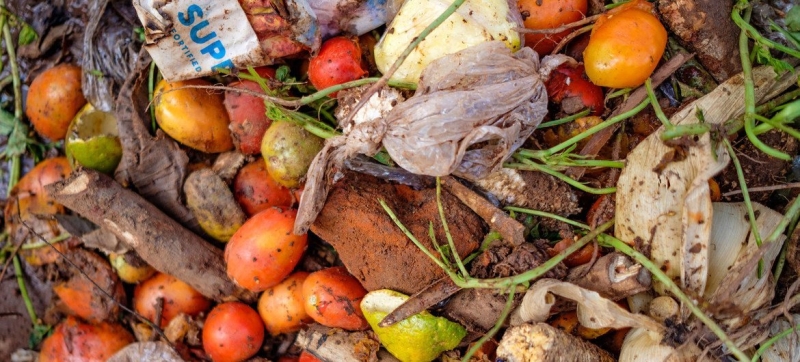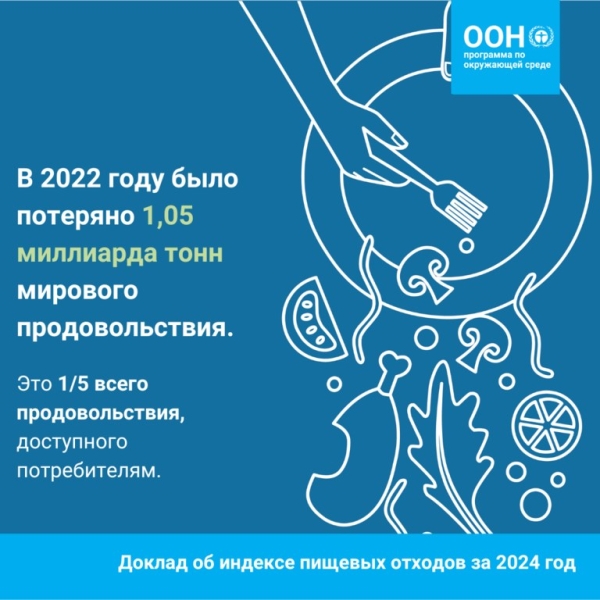
A fifth of all food available to consumers ends up wasted, a new UNEP report finds. While 783 million people go hungry, a fifth of food produced is wasted Climate and Environment
With 783 million people going hungry and a third of humanity facing food insecurity in 2022, households were wasting more than one billion meals a day. Food waste continues to wreak havoc on the global economy and contributes to climate change, environmental destruction and pollution. These are the main conclusions of a report by the United Nations Environment Program (UNEP).

Infographics
“Global Tragedy”
The report was produced in collaboration with WRAP, a global non-governmental organization dedicated to addressing the causes of climate change. According to the report, 1.05 billion tons of food waste (including inedible parts) was produced in 2022, amounting to 132 kilograms per capita and almost a fifth of all food available to consumers. Households accounted for 60 percent of total food waste in 2022, with food service accounting for 28 percent and retail accounting for 12 percent.
“Food waste is a global tragedy. Millions of people will go hungry today as food is wasted around the world,” said Inger Andersen, Executive Director of UNEP. “This is not only a serious development problem, but the consequences of excess waste lead to significant damage to the climate and nature. It is well known that if countries pay attention to this issue, they can significantly reduce food loss and waste, reduce climate impacts and economic losses, and accelerate progress towards global goals.”
Data Collection
Starting in 2021, the data collection infrastructure is being strengthened by increasing the number of studies tracking the food waste problem. The number of household-level data collection points around the world has almost doubled. However, many low- and middle-income countries still lack adequate systems to track progress towards achieving Sustainable Development Goal 12, which aims to halve food waste by 2030, particularly in the retail and foodservice sectors.
Only four G20 countries (Australia, Japan, UK, US) and the European Union have a food waste scale that is suitable for tracking progress to 2030. Canada and Saudi Arabia have suitable household scales, and Brazil’s scale will be ready by the end of 2024. In this context, the report provides practical guidance for countries to consistently measure and report on food waste.
Not Just a Rich Countries Problem
The data confirms that food waste is not just a rich-country problem, with levels of household food waste differing in observed averages for high-, upper- and lower-middle-income countries by just seven kilograms per capita. However, countries with hotter climates appear to generate more food waste per capita in households due to higher consumption of fresh food with more inedible parts and lack of reliable refrigeration.

Infographics
Food waste and greenhouse gas emissions
Recent data shows that food loss and waste contributes to 8-10 percent of global greenhouse gas (GHG) emissions, almost five times more than the aviation sector, as well as significant loss of biodiversity, covering an area equivalent to almost a third of agricultural land in world. The cost to the global economy from both food loss and waste is estimated at approximately one trillion dollars.
People in urban areas are expected to benefit most from measures aimed at to reduce food waste and introduce circular models. Rural residents tend to waste less food by feeding scraps to pets or composting them, report finds.

Infographics
National Climate Plans
As of 2022, only 21 countries have included reducing food loss and/or waste in their national climate plans. The 2025 plan review process provides an excellent opportunity to strengthen climate action by integrating data on food loss and waste into these plans. The report also highlights the importance of addressing food waste quickly, both at the individual and system levels.
Tracking Changes
Countries need reliable baseline data and regular surveys to reflect changes over time. Through policies and partnerships, countries such as Japan and the UK are demonstrating that large-scale change is possible – with waste reductions of 31 and 18 percent respectively. waste is causing enormous harm to the environment, society and the global economy, we need more coordinated action across continents and supply chains. We support UNEP’s call for more G20 countries to monitor their food waste and take action to achieve SDGs 12 and 3,” said Harriet Lamb, Director General of WRAP. “It’s very important that food ends up on plates and not in the trash.”

Infographics
International Day for a World Without Waste
In 2023, millions of people around the world celebrated the first International Day for a World without Waste, learning about national, subnational , regional and local initiatives addressing the waste problem and their contribution to achieving a sustainable development model.
Initiatives that address this issue can contribute to sustainable waste management and also minimize and prevent waste generation. To combat pollution, waste management needs to be strengthened while improving resource recycling and significantly reducing waste generation. Prevention, reduction, reuse, repurposing and recycling are critical to this endeavour.
United Nations Environment Program (UNEP) and United Nations Human Settlements Program (UN-Habitat ) promote this Day, which is celebrated on March 30th. All Member States, United Nations system organizations and relevant stakeholders are encouraged to implement initiatives to address the waste problem at local, regional, subnational and national levels.
